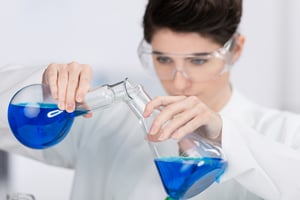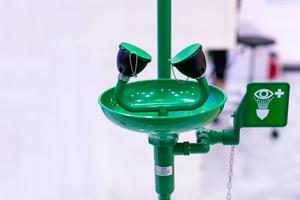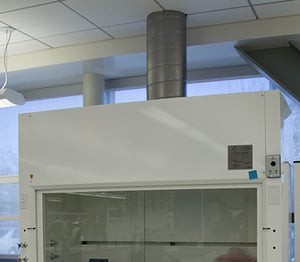Nearly every laboratory comes with risks. Whether those are hazardous chemicals, toxic fumes, sharp tools or exposures to infectious diseases, the risk of something going wrong is high when compared to many other workplaces.
Yet laboratories are generally considered safe thanks to lab safety equipment and procedures that are put into place to protect workers.
Pieces of lab safety equipment that every laboratory should have to reduce the risk for serious injuries include:
- Goggles and garments
- First aid kits
- Eye washing stations and showers
- Fire extinguishers and blankets
- Chemical spill kits
- Fume hood
- Safety storage cabinets
Goggles And Garments
Safety goggles are an important layer of eye protection. They help prevent them from being exposed to dangerous substances and chemicals.
dangerous substances and chemicals.
When choosing safety goggles, make sure you select the right design for your lab. Some goggles or safety glasses are designed to protect against physical impact while others are designed to protect against splashing chemicals. Some goggles even protect against lasers and UV lights. Goggles that wrap around the eyes, keeping chemicals from entering from the sides, are typically more effective than those that don’t.
In addition to goggles, garments that help protect employees from dangerous conditions found in the lab include:
- Coveralls
- Lab coats
- Face masks
- Boot covers or shoe covers
- Gloves
- Beard and hair covers
- Bouffant caps and hoods
- Intersuits worn under coveralls
Garments can come in a variety of materials, which should match the needs of your lab’s application. They can be disposable or reusable. If you choose reusable, check whether your lab has any laundering or sterilization requirements. If your application requires the cleanest conditions (ISO 1), it may be more cost-efficient to use disposable garments since you will require more complex laundering methods to avoid introducing contaminants.
If your laboratory setting has a clean room, you will need to make sure you have appropriate clean room garments as well. Clean room garments are generally lint-free and non-shedding. They are constructed using materials such as polyester or polypropylene.
Polyester is often used to create static dissipative fabric, which can be ideal for controlled environments where electrostatic discharge (ESD) is a concern. Polypropylene allows moisture to evaporate more quickly than traditional clothing. It is also resistant to many acids and alkalis.
First Aid Kits
Lab managers should strategically place several first aid kits around the laboratory, so they are readily accessible in case of an emergency. Ensure all lab technicians know where these first aid kits are located.
In each first aid kit, you should include:
- Bandages
- Scissors
- Tweezers
- Hand sanitizer
- Antibiotic ointment
- Antiseptic cream
- Sterilizing wipes
- Sterile dressings
- Gauze
- Eye dressings
Make sure these kits are restocked when needed and that all expired products have been removed.
Eye Washing Stations And Showers
Eye washing stations are standard pieces of lab safety equipment in most labs. If chemicals or foreign materials enter a technician’s eyes, it’s important to flush them out immediately.
enter a technician’s eyes, it’s important to flush them out immediately.
There should be several eye wash stations readily accessible eye washing stations throughout the workspace so laboratory personnel can quickly access them if an accident occurs.
Some labs may also require safety showers. These emergency showers are used when dangerous chemicals accidentally come in contact with a person's skin. An employee should first remove any contaminated clothing and then enter the shower. An overhead handle typically releases the water.
Fire Extinguishers And Blankets
Laws require that laboratories have multiple extinguishers on hand in the case of a fire. It is extremely important that the fire extinguishers you have on site address the types of hazards in the lab.
There are four types of fire extinguishers:
- Class A extinguishers, which are used for ordinary combustibles
- Class B extinguishers, which are used for flammable liquids and gases
- Class C extinguishers, which are used for electrical equipment
- Class D extinguishers, which are used for combustible metals and metal alloys
Each type of fire extinguisher is made with a special substance that will only extinguish a specific type of fire. If you do not use the right kind of extinguisher, you may fail to extinguish the fire or make it worse.
In the event of a fire, it’s also important to have several fire blankets available. Fire blankets are constructed using wool and are treated with flame retardant fluid. They are used to smother fires or wrap around a person whose clothes have been set on fire.
Chemical Spill Kits
When acids, corrosive substances or unknown liquids are spilled, chemical spill kits can help technicians safely clean the area.
You can purchase ready-made kits from manufacturers or put together a kit yourself. Kits should include items like:
- Disposable nitrile gloves
- Caution tape
- Hazardous waste bags and tags
- Neutralizing materials
- pH paper
- Plastic bags
- Mercury in-line vacuum trap kit
- Personal protective equipment (PPE)
- Dustpan and broom
All of the contents should be kept together inside the kit and the kit should be portable. If items are too large to fit in the kit, such as the dustpan and broom, make sure you include detailed instructions where these items can be found.
Fume Hood
A laboratory fume hood is an essential piece of laboratory equipment because it keeps technicians safe from toxic chemicals by providing a ventilation system.
toxic chemicals by providing a ventilation system.
What is a fume hood? A fume hood is an enclosed industrial workbench with an exhaust system that is designed to limit the person doing work from exposure to hazardous or toxic fumes, vapors or dusts. It has an enclosure on three sides, with the fourth side open for the lab worker to operate.
Fume hoods have a fan that creates a positive airflow to pull contaminants into the filtration system. There are two types of fume hoods: Ducted and ductless. The major difference in fume hood design occurs in the manner used for venting the contaminated air.
Ducted fume hoods have ductwork that is attached to the building and are stationery with a fixed position in the lab. This ensures that there is always adequate egress from the lab in case of fire or chemical dispersion. They can typically handle more chemicals, but may require infrastructure improvements or additions.
Ductless fume hoods operate off a carbon filter system that recirculates filtered air into your building. A ductless hood is often referred to as a portable fume hood because it is mobile. It is a great choice for using in existing buildings where ductwork is inaccessible, where mobility is necessary or cost is a concern since they come with a lower price than ducted fume hoods.
Our fume hood safety checklist shows how to keep a fume hood working at a high performance level.
Safety Storage Cabinets
Including durable cabinets in your lab design is more than about finding storage solutions. It’s also about health and safety.
In a lab setting, designated cabinets should be available to store flammable liquids, corrosives and other hazardous materials. These specialized cabinets are designed to reduce the risk of exposure and spills, as well as reduce the risk of fires in the lab space.
Variations of steel, such as stainless steel, are some of the most common materials used to construct lab cabinetry because steel components are heavy duty and provide maximum strength.
They are also an effective material choice for laboratories that require a sterile or hygienic environment. That’s important for many labs since the last thing they want is for liquids, bacteria, fungus or mold to penetrate your casework. You can read more about the advantages of these cabinets in our article, Top 6 Benefits Of Stainless Steel Cabinets.
An important feature to consider in addition to material is whether you need locks on your storage cabinets. If you work with pharmaceutical drugs or simply have expensive equipment that you want to protect, storage locks are a must.
If you are using the cabinets to store flammable liquids, you must use fire-resistant safety cabinets in order to meet any fire codes and regulations. These cabinets must meet OSHA and NFPA standards and help protect the building and employees if a fire occurs.
When choosing a safety storage cabinet, make sure you work with a manufacturer that helps you determine which type of cabinet you need for the liquids or substances you have onsite. The best industrial furniture cabinet makers will ensure you have the storage you want at the safety level you need so you can rest assured your laboratory is as safe as possible for your employees.


